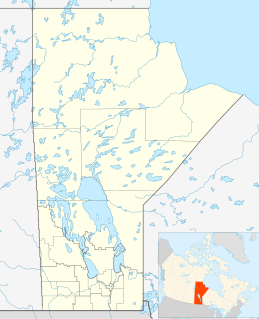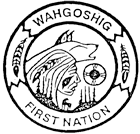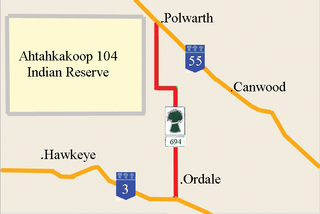First Nations in Alberta are Indigenous peoples who live in the Canadian province of Alberta. The First Nations are peoples recognized as Aboriginal peoples in Canada excluding the Inuit and the Métis. According to the 2011 Census, a population of 116,670 Albertans self-identified as First Nations. Specifically there were 96,730 First Nations people with registered Indian Status and 19,945 First Nations people without registered Indian Status. Alberta has the third largest First Nations population among the provinces and territories. From this total population, 47.3% of the population lives on an Indian reserve and the other 52.7% live in urban centres. According to the 2011 Census, the First Nations population in Edmonton totalled at 31,780, which is the second highest for any city in Canada. The First Nations population in Calgary, in reference to the 2011 Census, totalled at 17,040. There are 48 First Nations or "bands" in Alberta, belonging to nine different ethnic groups or "tribes" based on their ancestral languages.
First Nations in Saskatchewan constitute many Native Canadian band governments. First Nations ethnicities in the province include the Cree, Assiniboine, Saulteaux, Dene and Dakota. Historically the Atsina and Blackfoot could also be found at various times.
Gordon 86 is a Cree First Nation reserve in Saskatchewan, Canada located 61 kilometres (38 mi) northwest of Fort Qu'Appelle. It is one of three territories of the George Gordon First Nation, as arranged by the signing of Treaty 4. The reserve has an area of 14,438.3 hectares. It is also known as the George Gordon Reserve.
The Muskoday First Nation is a First Nation band government in Saskatchewan, Canada, composed of Cree and Saulteaux peoples. The First Nation has a registered population of 1,828 people as of September 2014, of which approximately 623 members of the First Nation live on-reserve, and approximately 1204 live off-reserve. Muskoday's territory is located in the aspen parkland biome. It is bordered by the rural municipalities of Birch Hills No. 460 and Prince Albert No. 461.

Misipawistik Cree Nation is a Cree community in Northern Manitoba. "Misipawistik" in the local Cree language means "Rushing Rapids", which was once a historical Canadian landmark before the construction of the Manitoba Hydro-electric Dam in the late 1950s.

Treaty 4 is a treaty established between Queen Victoria and the Cree and Saulteaux First Nation band governments. The area covered by Treaty 4 represents most of current day southern Saskatchewan, plus small portions of what are today western Manitoba and southeastern Alberta. This treaty is also called the "Qu'Appelle Treaty," as its first signings were conducted at Fort Qu'Appelle, North-West Territories, on 15 September 1874. Additional signings or adhesions continued until September 1877. This treaty is the only indigenous treaty in Canada that has a corresponding indigenous interpretation.
The Bigstone Cree Nation is a First Nations band government in Alberta, Canada. As Woodland Cree, they are a western branch of the larger Cree nation, and are a party to Treaty 8 with Canada. The Bigstone Cree Nation was divided into two bands in 2010, with one group continuing under the former name, and the other becoming the Peerless Trout First Nation.

Deer Lake First Nation is an Oji-Cree First Nation band government in Northern Ontario, located north of Red Lake, Ontario, Canada. It is one of the few First Nations in Ontario to have signed Treaty 5. It is part of the Keewaytinook Okimakanak Council and the Nishnawbe Aski Nation. As of December, 2007, the First Nation had 1,072 registered members, of which their on-reserve population was 868.
Waterhen Lake First Nation is a Cree First Nation band government located in northwestern Saskatchewan, Canada. As of October 2018 the total membership of the Waterhen Lake First Nation was 2,053. There were 983 members living on reserve, 2 on Crown Land and 1,068 members living off reserve. The First Nation is a member of the MLTC Program Services, a regional tribal Chiefs' Council. The First Nation is also a signatory to the Adhesion to Treaty 6 in 1921.

Wahgoshig First Nation, formerly known as Abitibi-Ontario Band of Abitibi Indians or simply as Abitibi, is an Anishinaabe and Cree First Nation band governments whose reserve communities are located near Matheson in Cochrane District in northeastern Ontario, Canada. They have reserved for themselves the 7,770.1 hectares Abitibi Indian Reserve No. 70 on the south end of Lake Abitibi. In January 2008, the First Nation had 270 people registered with the nation, of which their on-reserve population was 121.

Canoe Lake 165 is an Indian reserve of the Canoe Lake Cree First Nation in the boreal forest of northern Saskatchewan, Canada. Its location is on Canoe Lake approximately thirty miles west of Beauval, within ancient hunting grounds of the Woodland Cree. The reserve includes the settlement of Canoe Narrows.
Muskowekwan First Nation is a Saulteaux (Ojibway) First Nation who inhabit approximately 100 km northwest of Melville, Saskatchewan, Canada. As of May, 2008, the First Nation have 1,517 registered people, of which their on-Reserve population was 400.

Saskatchewan Highway 694 connects Saskatchewan Highway 3 in the Canwood No. 494 rural municipality (RM) to Saskatchewan Highway 55 at Polwarth. South of Highway 55, Highway 694 is named Hilldrop Road. The length of Highway 694 is 22.9 kilometres (14.2 mi) and extends north, in the north central area of Saskatchewan west of Prince Albert.

The Okanese First Nation is a Cree-Saulteaux First Nation band government in Balcarres, Saskatchewan, Canada.

The Mathias Colomb First Nation, Mathias Colomb Cree Nation (MCCN), Mathias Colomb (Cree) First Nation, Pukatawagan/Mathias Colomb Cree Nation is a remote northern Manitoba First Nation, located 210 kilometers north of the Town of The Pas and 819 northwest of the City of Winnipeg, Manitoba, which had two reserves under its jurisdiction, IR 198 and IR No. 199. The main community is at Pukatawagan, Manitoba. IR Pukatawagan 198 consists of 1536.6 hectares on the shore of Pukatawagan Lake and lies about 210 kilometers north of The Pas, Manitoba. Their second reserve was the Highrock reserve (CSD) located on Highrock Lake, 30 km downstream from Pukatawagan, which was dissolved by 2006.

Montreal Lake Cree Nation is a Woodland Cree First Nation in the boreal forest of central Saskatchewan, Canada. Its reserve, Montreal Lake 106, is on the southern shore of Montreal Lake 103 km (64 miles) north of Prince Albert and 167 km (104 miles) south of La Ronge. Highway 969 passes through the village.
Saddle Lake Cree Nation is an Amiskwacīwiyiniwak division of the Plains Cree, historically speaking the Plains Cree language and located in central Alberta. The Nation is a signatory to Treaty 6. This First Nation's governing structure is unusual in that it has two separate councils and chiefs governing different Indian reserves, one called the Saddle Lake Cree Nation (proper) and the other called the Whitefish Lake First Nation, often called "Whitefish (Goodfish) Lake First Nation" to distinguish it from a similarly named group in Manitoba. For the purposes of the Indian Act however the Saddle Lake and Whitefish are one band government.

Mistawasis born as Pierre Belanger was also known as “Piwaspiskomostos”, and “Mistahi Awas Asis, or Mistawasis”. He was a Chief of the Sak-kaw-wen-o-wak Plains Cree, notable for his role as the leader of his people during the signing of Treaty 6 in 1876. He was born circa 1796 to a French father, Bernard Belanger, and a Nakoda mother, Kakakewachin near Slave Lake in what is now the province of Saskatchewan, Canada. Due to the dwindling buffalo population caused by excessive hunting, he was forced to look for new strategies to ensure the survival of his people and their culture. The loss of the buffalo threatened his people and he believed that the only way to save his people would be to negotiate with the Canadian Government. He held great influence over his people and it was due to this influence that he, and his close ally Ahtahkakoop, were able to argue successfully for the adoption of Treaty 6 by his fellow Cree. Mistawasis made history as the first signatory of Treaty 6. After the treaty was signed he remained an ally of the Canadian government until his death.









